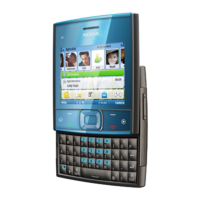
Do you have a question about the Nokia X5-01 and is the answer not in the manual?
| Panel type | TFT |
|---|---|
| Display diagonal | 2.36 \ |
| Display resolution | 320 x 240 pixels |
| Display number of colors | 262144 colors |
| Ringer type | Polyphonic |
| Processor frequency | 0.6 GHz |
| Internal memory | 200 MB |
| Maximum memory card size | 32 GB |
| Rear camera type | Single camera |
| Rear camera resolution | 2592 x 1944 pixels |
| Video capture resolution (max) | 640 x 480 pixels |
| Headphone connectivity | 3.5 mm |
| USB 2.0 ports quantity | 1 |
| Text prediction system type | T9 |
| Multimedia Messaging Service (MMS) | Multimedia Messaging Service (MMS) is a standard way to send messages that include multimedia content to and from a mobile phone over a cellular network |
| Audio formats supported | AAC, AAC+, AU, eAAC+, M4A, MP3, MP4, WAV, WMA |
| Image formats supported | BMP, PNG |
| Talk time (2G) | 5 h |
| Standby time (2G) | 408 h |
| 2G standards | EDGE, GPRS |
| Data network | 3G, wcdma |
| Bluetooth version | 2.1+EDR |
| SIM card capability | Single SIM |
| Form factor | Slider |
| Product color | - |
| Keyboard layout | QWERTY |
| Depth | 16.85 mm |
|---|---|
| Width | 66.44 mm |
| Height | 74.3 mm |
| Weight | 129 g |
Guidelines for safe device operation to prevent danger or interference.
Emphasizes obeying traffic laws and keeping hands free while driving.
Explains susceptibility to interference affecting device performance.
Details the device's network compatibility and specifications.
Explains requirements and limitations of network services for device features.
Identifies and labels the physical components of the device.
Provides step-by-step instructions for inserting SIM and battery.
Guides on charging the device battery, including initial charging.
Guides on transferring data from an old device using the Switch application.
Lists keyboard shortcuts for efficient device operation.
Covers initial device configuration like regional settings and mail accounts.
Guides through configuring e-mail and connection settings.
Explains the home screen as the starting point for contacts and shortcuts.
Explains the meaning of various icons on the device display.
Explains how to use the device's keyboard for input and character entry.
Customizing ringing tones, alert tones, and device tones for different situations.
How to set custom ringing tones for profiles or contacts.
Customizing the device's visual appearance through themes.
Instructions for initiating voice and video calls.
How to answer, reject, or mute incoming calls.
Accessing and managing voicemail services.
How to set up and manage multi-party calls.
Setting up call forwarding to voicemail or other numbers.
Managing contact entries, including saving and editing.
Process for creating and adding new contacts.
Customizing ringtones, images, and call text for contacts.
Overview of sending and receiving text, multimedia, and e-mail messages.
Step-by-step guide to composing and sending messages.
Wizard for configuring corporate and internet e-mail accounts.
Using the feature to listen to text, multimedia, and audio messages.
Overview of the music player application.
Instructions for selecting and playing audio content.
Creating and managing custom song playlists.
Methods for moving music files from PC to device.
Using the device as an FM radio receiver.
Introduction to the device's camera functionality.
Step-by-step guide to taking photos.
Instructions for recording video clips.
Overview of the Gallery application for managing media files.
Posting images and videos to online sharing services.
Introduction to the device's web browser.
Navigating to web pages using bookmarks or addresses.
Storing and accessing favorite web pages.
Clearing cache memory for security and performance.
Introduction to the calendar application for scheduling events.
Creating various types of calendar entries like meetings and memos.
Configuring the device's time, date, and automatic updates.
Setting and managing alarms on the device.
Creating and managing notes, memos, and lists.
Using the device's built-in calculator for simple calculations.
Overview of the unit and currency converter tool.
Creating and managing compressed archive files.
Understanding data connections and required access points.
Configuring network modes (GSM/3G) and operator selection.
Information about connecting to wireless local area networks.
Process of pairing the device with other Bluetooth devices.
Overview of managing device applications.
Steps for installing software and applications onto the device.
Introduction to the file manager for browsing and managing files.
Creating backups of device memory to a memory card.
Adjusting settings for individual applications.
Managing PIN, lock codes, and keypad autolock.
Resetting the device to its factory default settings.
Resources for getting help and troubleshooting device issues.
Importance of updating device software and applications.
Instructions for checking and downloading software updates wirelessly.
Information on PIN, PUK, and lock codes.
Ways to conserve battery power when using the device.
Information on recycling electronic products and packaging.
Guidelines for charging, using, and maintaining the battery.
How to verify the authenticity of Nokia batteries.
Recommendations for protecting the device and maintaining warranty.
Precautions regarding interference with medical devices.
Safety advice for users with implanted medical devices.
Safety measures for using the device in hazardous areas.
How to make emergency calls and network dependency.
Device compliance with radio wave exposure guidelines (SAR).
Nokia's commitment to protecting user privacy and data.
Categories of personal data collected by Nokia.
User rights regarding personal data access, rectification, and deletion.